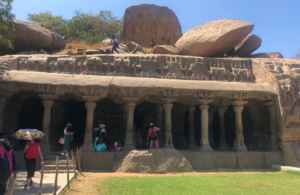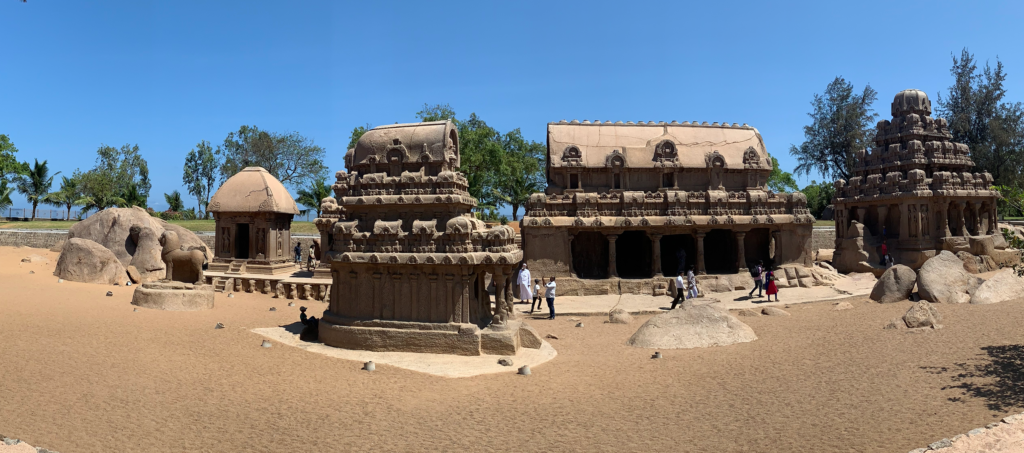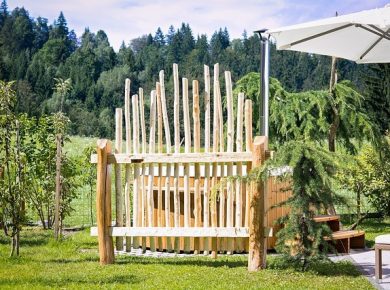The first place where I visited this year was Mahabalipuram and for now, it’s the last place due to the lockdown. While I’m trapped in the four walls of my house, I can’t help but scroll through my phone gallery and get reminded of the trip.
Major throwback scenes!
Anyway, I had visited Chennai in the first week of March and the plan was to cover Pondicherry and Mahabalipuram in our 4 days short trip. We had kept Mahabalipuram for the last day as it’s just an hour’s drive from Chennai. A bit more maybe.
History, ruins, and old legends immediately grab my attention. No wonder this old town which was once a bustling seaport and a busy trading center has my heart. This place is now one of the major tourist attractions near Chennai.
The town was once ruled by the Pallavas and was famed for its excellent architecture and sculptures. We found sculpting shops on either side of the road while we were exploring the town. You can marvel at the tall sculptures of Ganesha and Buddha on one side and tiny sculptures of elephants and chariots with intricate carvings on the other. The town also has rock-cut monuments that draw architects, history enthusiasts, and travelers from around the world.
But for me, it was also about the golden beach, finger-licking authentic food, and surfing.
Mamallapuram was named after Pallava king Narasimhavarman I, who was also known as Mahamalla. This town rose to become one of the major port cities within the kingdom in the 7th century.

We started our sightseeing journey from a magnificent base relief called Arjuna’s Penance or Descent of the Ganges which dates back to the mid-seventh century and depicts the story of Kiratarjuna, of the great epic Mahabharata.
The monolith is 43 feet in height and 96 feet in width. It was carved on two huge adjoining boulders. The panoramic view of life in the forest is aptly sculptured here in the two large boulders. The great event of obtaining the weapon Pasupatha from Lord Shiva by Arjuna is portrayed here. This event is depicted as if it is witnessed by the three worlds. Some scholars identified this panel with a story of Bhagiratha bringing the Ganges to the earth and thus it is also called the Descent of the Ganges.
Stone sculpture representing a group of monkeys
This small monolithic sculpture of a monkey group was found while cleaning the sand in front of Arjuna’s penance to expose it completely. It is a realistic carving of a group of monkey families consisting of father, mother, and child. One of the parents is removing lice from the head of the other while the little one is resting on the lap of the mother monkey. The sculptor tried to show the delightful delineation of life in the sculpture.
Ganesha Ratha:

The monolithic temple, dedicated to Siva, is known as Atyantakama Pallavesvaram from the inscription of this temple. The title Atyantakama is identified with Paramesvaravaman-1. This monolithic temple is rectangular in plan and has a narrow Mukha mandapa which has two lion pillars and pilasters. The ratha was previously known as Arjuna Ratha due to its location, near the Arjuna Penance relief. Kavali tells that a shivalinga was installed inside the sanctum however that linga was removed by a British officer. Then the locals put a Ganesha image inside. Since then it is known as Ganesha Ratha.
Krishna’s butterball:

Krishna’s butterball is a gigantic boulder delicately balanced by nature on the slope of the hillock. It is also known as ‘Stone of the Sky God’ or the ‘Vaanirai Kal’ by the locals. The boulder weighs around 250 tons and is approximately 6 meters high and 5 meters wide. It stands on an approximately 1.2 meter base on the slope. Even though it’s called Krishna’s butterball by the local people, it has no relation with Lord Krishna. There was an attempt to remove the boulder- once by Pallava King Narasimhavarman and later by the Governor of Madras Arthur Lawley. However, both attempts were unsuccessful.
Triple celled rock-cut shrine:

On stylistic grounds, these rock-cut shrines are assignable to the early period of Pallava king Paramesvaravarman 1 and on typological grounds to Mamalla style. There are three shrines dedicated to Brahma, Siva, and Vishnu. The shrine of Siva is slightly larger than the others. There is a pair of dvarapalas guarding the entrance of each shrine, one on either side. Further, north of these shrines is a niche dedicated to Durga.
Kottikal mandapa:

Stylistically dated to earlier years of Pallava king Narasimhavarmn Mamalla, but typologically assigned to period 2 of Mahendra style. There is a short title inscription on the southern pillar in the 7th-century grantha script reading Sri-vamankusa, a title neither borne by mahendravarman or Narsimhavarman 1. The title likely belonged to a chieftain possibly of Telugu Cholas. On either side of the entrance to the shrine are sculptures of dvarapalikas indicating that the cave may have been dedicated to Durga.
The unfinished rock-cut cave temple:

This cave temple would have been the largest of all the cave temples of the Pallavas. On the stylistic grounds, it may be placed later among the Mamalla style cave temples in the period of Paramesvaravarman 1. This cave temple has a unique plan in having a rock-cut shrine at the back of the façade hall with an unfinished passage for circumambulation. Locally, this temple is known as Panch Pandava mandapa. The cave temple is unfinished and the columns of the verandah, which have lion bases, are a typical style of Pallava architecture.
All the above-mentioned temples and structures were in one place. It took us two hours to cover them. This includes our photo sessions as well.
The next destination we headed to was the Pancha Rathas, also referred to as Pandava Rathas.

The five structures or chariots are carved out of large stone blocks and date back to the 7th century during the reign of the Pallava dynasty. The five rathas are named as ‘Dharmaraja Ratha’, ‘Bhima Ratha’, ‘Arjuna Ratha’, ‘Nakula Sahadeva Ratha’, and ‘Draupadi Ratha’ after the five Pandava brothers and their common spouse Draupadi from the great Indian epic ‘Mahabharata’.
It was getting really hot and so we didn’t spend much time over here and wanted to head to someplace with a roof! This is when Google told us that we must visit the Seashell Museum, the largest seashell museum in Asia. You will find different kinds of shells, fossils, and corals. There is also a shopping center inside the museum where one can buy sea products of different types.
Our last stop in Mahabalipuram was the famous Shore temple. It was evening by the time we visited the temple and the cool breeze from the sea washed away our tiredness from the day.

The shore temple is the earliest representation of a structural temple at Mamallapuram belonging to the Pallava rajasimha period. The temple is built out of cut stones, unlike most of the other monuments at the site. Shore temple is a complex of 3 temples, two of which are dedicated to Lord Shiva and one to Lord Vishnu.
The temple was named ‘Seven Pagodas’ which indicates the existence of seven temples in the past. The existence of Mamallapuram and the Seven Pagodas have also been recorded by some European travelers.
In 1984, the Mamallapuram monuments and temples, including the Shore Temple complex, were collectively designated a UNESCO World Heritage site. The existence of more temples around the Shore Temple has also been recorded.
Mahabalipuram also offers lessons in surfing, Stand-Up paddle, and Kayaking. We spent the rest of our evening on a rooftop cafe overlooking the sea.
To our left, people were surfing and enjoying the sea breeze, and to our right, The Shore Temple stood calmly as it has for years now.
It was a perfect day.










